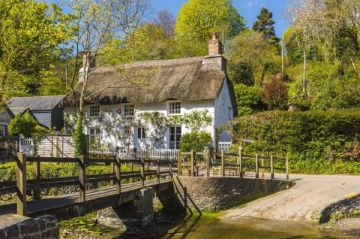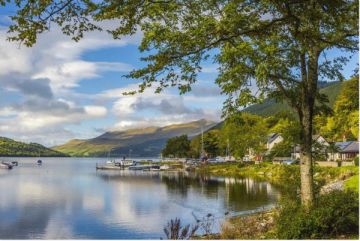This profile of HRH Prince William appeared in the September 1999 issue of The Royal Report.
As the Royal party partook of a Mediterranean cruise around the Greek islands on the yacht Alexander this summer, the Prince of Wales had good reason to be proud of his elder son. Showing not only his emotional sensitivity, but a mature understanding of his father’s needs, Prince William suggested that Charles’s long-term companion Camilla Parker Bowles be invited join the party. Otherwise, the Prince noted, his father would be forced to spend a month apart from Mrs Parker Bowles: during the luxury 10-day cruise, and afterwards for the traditional two-week break at Balmoral, the Queen’s Scottish residence. The cruise, one commentator noted, appeared to mark the end for the 17-year-old Prince of a two-year period of grief and upheaval.
In the early hours of August 31, 1997, while holidaying at Balmoral, William awoke to the news that his mother and her lover had been fatally wounded in a car accident in Paris. In the two years that have followed, William has shown courage and maturity beyond his years, and has transformed from a shy teenager, with his loyalties torn between love for his mother and duty towards his father, into an independent, strong-willed young man with the destiny of the Monarchy on his shoulders.
The elder son and heir of the Prince and the late Princess of Wales was born on June 21, 1982 in the Lindo Wing of St Mary’s Hospital, Paddington, London, weighing in at 7lb 10oz after a lengthy labour. The boy was christened William Arthur Philip Louis Windsor, with water from the River Jordan, in the music room of Buckingham Palace on August 4, 1982, coinciding with the 82nd birthday of the Queen Mother.
Both parents wanted William, and later Harry, to have as normal a childhood as possible. Unlike previous heirs to the throne, who were educated at home by private tutors at the same age, William’s formal education began at the age of three at Mrs Mynor’s Nursery School in Notting Hill Gate, West London. It continued at Wetherby, a nearby preparatory day school, where emphasis was placed on music and manners.
At first, Princess Diana was against sending William to boarding school. Prince Charles, remembering the misery of his own schooldays, equally did not want his son to suffer as he had at Gordonstoun. But for reasons of security, a compromise was reached. Aged eight, William was sent to Ludgrove Preparatory School in Wokingham, Berkshire, where he boarded on weekdays only. His school reports revealed his talent on the sports field, where he impressed as a rugby and hockey team captain, a crack shot, an excellent football and basketball player, and a school representative at cross-country running and swimming.
Diana described him as “the man in my life”, and the most photographed woman in the world relied upon her elder son for comfort and advice. Their relationship was close: Wills even announced that he wanted to be a policeman when he grew up, so that he could protect his mother. (“You can’t,” Harry observed, “you’ve got to be King.”) On one occasion, when Diana locked herself in the bathroom after an argument with Charles, it was William who pushed tissues under the door with a note saying: “I hate to see you sad.” By the age of nine, he had already learned to book a table at San Lorenzo, her favourite restaurant, to cheer up his mother. It was William who later advised her to accelerate her divorce proceedings by agreeing to be stripped of the title HRH, reassuring her: “You’ll still be Mummy.”
In turn, “Mummy” took William on a number of visits to meet the homeless and the dying, to make him aware of others’ suffering. “I want William and Harry to experience what most people already know,” Diana told an interviewer. “That they are growing up in a multi-racial society in which everyone is not rich, or has four holidays a year, or speaks standard English and drives a Range Rover.”
At 13, William was sent to Eton College, close to Windsor, a choice well-suited to a boy with a public future, not least because his new classmates would be as well-connected and as well-heeled as he: the Prince would not even be the only boy with a private detective. It became a regular arrangement that, on Sunday afternoons at 4pm, he would take tea with the Queen at the castle on the hill, where they continue to discuss William’s Royal duties – which at this stage include scheduling official photo calls and the occasional walkabout. William is not likely to begin taking on his own major Royal duties until he has completed his education. Unlike his father, there will be no formal title awaiting Prince William when he comes of age.
William developed an early sensitivity to the needs of others. Aged 14, he took the bold step of asking his parents not to attend the most important day in the school calendar, Eton’s Fourth of June celebrations, as he believed the presence of the press and bodyguards would spoil this Parents’ Day for his peers. Charles and Diana were both taken aback when he instead invited Tiggy Legge-Bourke to attend. Engaged by Prince Charles as unofficial nanny to the boys, Ms Legge-Bourke, whose mother was appointed Lady-in-Waiting to the Princess Royal, is a close companion with whom William feels naturally at ease. With a sense of fun that delights both William and Harry, Ms Legge-Bourke has noted: “I give the Princes what they need – fresh air, a rifle and a horse.”
William continues to flourish at Eton. His housemaster Dr Andrew Gailey, a respected constitutional historian and music lover from Northern Ireland, has taken William under his wing educationally and emotionally, and has been an important influence as William has sought to rebuild his life. Having proven to be the fastest junior swimmer at Eton in 10 years, from this term William will captain the swimming team, holding the title of Joint Keeper of Swimming. His duties include team selection, greeting visiting teams, keeping records, training new boys, and recommending swimmers for their colours. William has also been appointed secretary of the renowned Agricultural Club, and recently received Eton’s Sword of Honour, the school’s highest award for a first-year army cadet.
In addition, senior pupils have elected him to the élite Eton Society, one of the highest honours bestowed on boys at the top of the school. The exclusive club, known as “Pop”, is a selection of the 11 most popular and respected boys going into the upper sixth. William will ensure that younger boys attend a daily chapel service, serve as an usher at school plays, and gain the authority to fine pupils who break the school rules.
“My boy’s got a good brain,” Diana would note proudly, “considering how hopeless both his parents were.” And close to the first anniversary of his mother’s death, William, who had gained three GCSE passes the previous year, received a further nine GCSEs with top A* and A grades in English, history and languages, and Bs for other subjects including maths and science. He returned for his final year at Eton on September 8 to take geography, English and history of art at A level.
It was long presumed that the Prince would follow in his father’s footsteps by attending Trinity College, Cambridge. This decision had been made for Charles by a committee of advisers, but William will be given more freedom. “God help anyone who tells William what to do,” observed one courtier. “He listens, but he won’t be pushed around by the system.” Indeed, William has told friends that he wishes to attend Cambridge only if his grades merit a place, and that rather than gain favouritism he would rather attend one of his four other choices. These are Edinburgh, St Andrews, Bristol and Durham universities, all of which the Prince has recently visited.
History of art is likely to be his chosen subject. An army career will probably follow. “In the medium term, William wants to go into the armed services in some form,” says his uncle, Earl Spencer. “It is a traditional part of the Royal upbringing, but he would actually like to do it of his own volition.”
William values his privacy as well as his independence. At St James’s Palace, where he and Prince Harry share an apartment with their father, William has his own suite of rooms to which only he holds the key. He recently asked his father if he could convert the cellars of Highgrove House, the Gloucestershire home of the Prince of Wales, into his own flat. So far Papa is undecided. Like any other teenager, the second-in-line to the throne listens to techno music, selects all his own clothes, and enjoys playing computer games.
For his seventeenth birthday, William was given a VW Golf car by Charles, and soon afterwards passed his driving test at the first attempt. He had been driving on the private roads of the Royal estates from the age of 13, but received just 20 hours of tuition from Police Sergeant Chris Gilbert, an expert in anti-hijack and counter-surveillance techniques, before passing his test in a silver Ford Focus on loan to the Royal Estate. The Prince was praised by his instructor for his “natural flair for driving”, and will continue lessons to make him more confident at night and motorway driving.
Recently, William has taken up his father’s beloved sport of polo, despite being a left-handed player in a game which favours the right-handed. Although he is not always comfortable in the public gaze, all eyes were on William when he made a low-key appearance in the company of the new young polo set at the Cartier International Polo Day at Smith’s Lawns, Windsor, this season.
At six-foot one-and-a-half-inches tall, with self-assured elegance and those coy, head-lowered glances inherited from his mother, William has become the focus of much female attention – which embarrasses him terribly. He has chosen to socialise only with girls from families known to him. Informal dates are out of the question, and any future girlfriends will be thoroughly vetted to exclude the unsuitable and welcome the socially preferred. He only has to mention his interest in a young lady for an approach to be made to her parents by St James’s Palace. Mother and daughter will then be invited to tea or a party.
Similarly, if William appears to be getting on well with a classmate’s sister or friend, networking will go on behind the scenes and introductions made. His circle includes Lady Iona Douglas Home, Holly Branson, Emilia D’Erlanger and Zara Simmonds, among many other attractive young women.
“William has so much sheer personal confidence for his age, but it has absolutely nothing to do with his position,” observes one Royal insider. “At the same age, his father was a mess of uncertainties. William always seems to know where he’s going and he always gets what he wants.” As he reaches adulthood, Prince William has already demonstrated that he possesses the maturity, sensitivity and strength he will need to rise to his destiny as the future of the Monarchy.

Contents copyright 1999-2001 The Royal Report
NOTE: The Royal Report is sadly no longer online.



